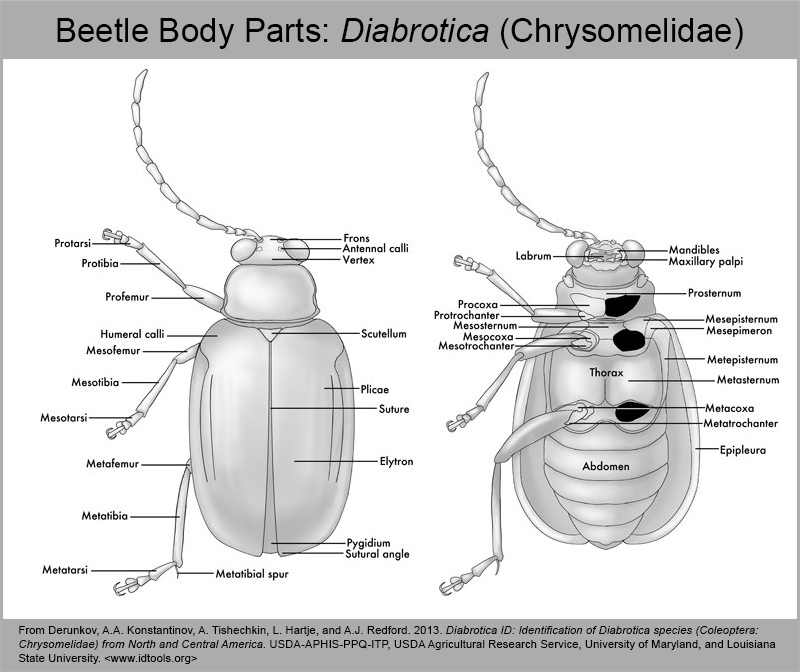Body length: 4–7 mm.
Eyes: eye interommatidial setaeseta:
a sclerotized hair-like projection of the cuticle
present, eye deeply emarginateemarginate:
notched at the margin > half width, eye ommatidial density coarse.
> half width, eye ommatidial density coarse.
Antennaeantenna:
in larval and adult insects, paired segmented appendages, borne one on each side of the head, functioning as sense organs and bearing a large number of sensilla
: antennal length reaches between basebase:
the part of any appendage or structure that is nearest the body
and end of elytraelytron:
the leathery forewing of beetles, serving as a covering for the hind wings, commonly meeting opposite elytron in a straight line down the middle of the dorsum in repose
or reaching/surpassing end of body, antennal flagellar segments elongateelongate:
much longer than wide
, scapescape:
the first proximal segment of the antenna smooth/punctate at apexapex:
smooth/punctate at apexapex:
end of any structure distad to the base
, antennal scapescape:
the first proximal segment of the antenna ≥ segment 3.
≥ segment 3.
Pronotumpronotum:
the upper and dorsal part of the prothorax
: pronotumpronotum:
the upper and dorsal part of the prothorax
shape longer than wide, rarely subquadratesubquadrate:
not quite a square
, pronotumpronotum:
the upper and dorsal part of the prothorax
lateral armature absent or blunt tubercule.
Prosternum: prosternal processprosternal process:
a posterior extension of the prosternum between the coxae dilated at apexapex:
dilated at apexapex:
end of any structure distad to the base
, procoxal cavities closed posteriorly.
Elytraelytron:
the leathery forewing of beetles, serving as a covering for the hind wings, commonly meeting opposite elytron in a straight line down the middle of the dorsum in repose
: elytral length reaching or close to end of abdomen, elytral apicesapex:
end of any structure distad to the base
rounded or truncatetruncate:
cut off squarely at the tip
, elytral color black, brown, yellow, reddish, or orange, elytral color pattern present or absent.
Legs: visible tarsomerestarsomere:
subdivision or article of the tarsus, usually numbering from two to five : 4, femora clavateclavate:
: 4, femora clavateclavate:
thickening gradually toward the tip
, slender or robust, protibial spursprotibial spur:
sclerotized spine(s) located at the distal tibia; can be single, double, or absent : 2, tarsal clawstarsal claw:
: 2, tarsal clawstarsal claw:
usually paired claws of the pretarsus, at the distal end of the leg simple.
simple.
Head with front sloping anteriorly; antennaeantenna:
in larval and adult insects, paired segmented appendages, borne one on each side of the head, functioning as sense organs and bearing a large number of sensilla
usually at least 1/3 longer than body in male, barely longer than body in female, segments 3 and 4 subequal in length, basal segments without long, apical hairs; clypeusclypeus:
that part of the insect head below the frons, to which the labrum is attached anteriorly with a deep, arcuatearcuate:
with a deep, arcuatearcuate:
arched or bow-like
impression above; palpi short. Pronotumpronotum:
the upper and dorsal part of the prothorax
longer than broad, constricted near basebase:
the part of any appendage or structure that is nearest the body
, narrowly so before apexapex:
end of any structure distad to the base
. Elytraelytron:
the leathery forewing of beetles, serving as a covering for the hind wings, commonly meeting opposite elytron in a straight line down the middle of the dorsum in repose
parallel-sided or slightly widened posteriorly, apexapex:
end of any structure distad to the base
broadly rounded. Legs elongateelongate:
much longer than wide
, first segment of posterior tarsitarsus:
the leg segment distal to the apex of the tibia, bearing the pretarsus; consists of one to five tarsomeres (including pretarsus)
as long as following 2 together (Linsley 1963Linsley 1963:
Linsley EG. 1963. The Cerambycidae of North America. Part IV. Taxonomy and Classification of the Subfamily Cerambycinae, Tribes Elaphidionini Through Rhinotragini. University of California Publications in Entomology, Vol. 21. 165 pp.).
Stenhomalus, Chinobrium, Uenobrium
The tribe Obriini has anterior coxal cavities rounded externally and closed behind, closed mesocoxal cavities, and an elongateelongate:
much longer than wide
first abdominal segment. Obrium differs from similar Asian genera Stenhomalus and Chinobrium by the metepisternummetepisternum:
the episternal portion of the pleuron on the posterior thoracic segment possessing a deep longitudinal groove. Uenobrium has an elongateelongate:
possessing a deep longitudinal groove. Uenobrium has an elongateelongate:
much longer than wide
hairy pronotumpronotum:
the upper and dorsal part of the prothorax
with raised swellings on its disc.
Worldwide except Australasia
broadleaf; Abies, Pinus, Larix, Pseudotsuga
92 species. Obrium is a large genus, dominant in tropical and subtropical America but also represented in the Old World. Conifers: O. californicum, O. brunneum.
Phyton Newman, 1840
Diozodes Haldeman, 1847
Obrium Dejean, 1821